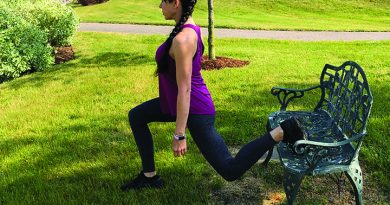Exercise without supplementation suicidal?
By Sari Huhtala
After nearly 15 years I finally connected the dots as to why my daily hard-core sweaty workouts were practically suicidal, and now understand why famous athletes, like 27-year-old basketball star Reggie Lewis, die of a heart attack, despite their superstar health status.
What’s more, exercise without supplementation can lead to mental health issues like depression, antisocial behaviour and even bipolar disorder.
Exercise without mineral supplementation is a health disaster waiting to happen, according to Dr. Joel Wallach, who has published over 70 peer-reviewed studies on nutritional deficiency diseases and pharmacology and is the author of Dead Doctors Don’t Lie.
Like countless others, I believed if my diet consisted only of wholesome, healthy foods, and superfoods, I did not need supplementation. When I landed myself in the emergency department one day, nearly two decades ago, thinking I was having a heart attack, the medical doctor didn’t even mention the risks involved with daily sweaty workouts without supplementation. After running a battery of tests, he simply looked at me and concluded “Clearly you are very healthy and fit. You’re a medical conundrum.”
Maybe the average doctor doesn’t even understand how crucial vitamins and minerals are for health? If they did, shouldn’t they be talking about it?
I began supplementing with quality vitamins and minerals, following the advice of a natural health practitioner, and the bizarre “medical conundrum” heart symptoms, like arrythmia, a racing heart, or the occasional odd heart pounding, all came to an end. Coincidence?
The human body requires 90 essential nutrients to maintain health – 60 of which are minerals. Most of these nutrients the body cannot produce on its own and relies on supplementation and nutrition to prevent deficiencies, Wallach explains. Sweating causes the loss of essential nutrients.
It’s more than just electrolytes lost during sweating. Sweating causes the loss of vital minerals like selenium, chromium, vanadium, lithium and copper. A deficit in these minerals can not only lead to heart issues like cardiomyopathy, but also aneurysms, diabetes, depression and antisocial behaviour, he explains.
After having conducted 3,000 autopsies on humans and 17,500 autopsies on over 454 species of zoo animals, Wallach concluded all of the people and animals who died of “natural causes” actually died from mineral deficiencies.
Selenium is vital for the prevention of cardiomyopathy, a muscular dystrophy of the heart muscle. Reggie Lewis was diagnosed with cardiomyopathy. The Boston Celtics hired 12 world-class cardiologists to help Lewis, after he collapsed during a game of basketball in the spring of 1993. World class cardiologists didn’t figure out the selenium connection. Lewis died of a second heart attack in summer 1993.
In 1957 animal studies proved a deficiency in selenium resulted in not just cardiomyopathy – referred to as Keshan Disease in humans – but also muscular dystrophy. By the 70s, the WHO had scientifically proven the link between heart health and selenium deficiency.
Prior to 1972, 13 out of 1,000 preschoolers, teens and pregnant women died of Keshan disease in China’s Keshan Province. In the Province of Keshan, the soil was nearly 100 per cent depleted of selenium. In the 30s, scientists believed Keshan disease was caused by a viral infection.
In the 70s, the World Health Organization sent a team of pathologists to Keshan to investigate. One of the scientists was an animal pathologist and recognized the condition as a lack of selenium. The WHO funded a double-blind, two-year study involving 48,000 children in Keshan to scientifically prove the selenium deficiency theory. Daily selenium supplementation was given to 39,000 children in the study, while 9,000 children, part of the control group, were given a placebo. Cardiomyopathy in children receiving selenium supplementation fell to zero cases over the two-year study. The case rate among the control group of children stayed unchanged at 13 per 1,000.
Sweating out all of your copper stores, without replenishing with supplementation, places you at risk of developing joint issues, varicose veins, and worse, a fatal ruptured aneurysm, Wallach explains.
Sweating out all of your chromium, vanadium and/or lithium can lead to diabetes and antisocial behaviour or depression, or even bipolar disorder and addictions to drugs or alcohol. This could explain why athletes like figure skater Tonya Harding became aggressive – sociopathic – and addicted to drugs and alcohol after years of athleticism, Wallach points out.
Wallach also draws the connection between a zinc deficiency aggravated by conditions like celiac disease, or other gut conditions that prevent nutrients from being absorbed, and anorexia and/or bulimia. Statistically 62 per cent of female gymnasts at university level are anorexic and/or bulimic. Without supplementation, developing anorexia and/or bulimia may be possible.
Sweating out gallium mineral stores, and never replacing them, places you at a risk of developing a brain tumor, Wallach explains.
Joint issues? Arthritis? Sweating out essential minerals like calcium, manganese, boron and magnesium without replenishing through supplementation may be exacerbating the problem.
Not an athlete or exercise buff? There’s still cause for deficiency concern, according to the U.S. Department of Agriculture and the CDC. They state that 90 per cent of Americans are deficient in potassium, 80 per cent are deficient in vitamin E, 70 per cent are deficient in calcium, 50 per cent are deficient in vitamin A, C and magnesium, and over 50 per cent of all individuals, regardless of age, are deficient in vitamin D. Over 70 per cent of elderly people are deficient in vitamin D, and over 90 per cent of Americans of colour are deficient in vitamin D.
In the 30s, the U.S. Congress was informed that farmlands were already lacking in micronutrients, causing over 99 per cent of Americans to be deficient in essential minerals.
Sari Huhtala is the publisher and editor of Alive and Fit Magazine. She has over 25 years experience in journalism, and over 15 years as a certified personal trainer and fitness specialist, as well as over 20 years as a wellness advocate.
Photo credit: ©[Rido) via Canva




